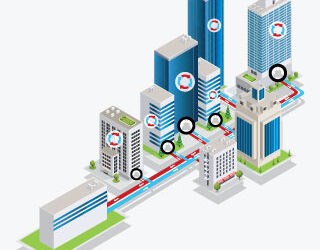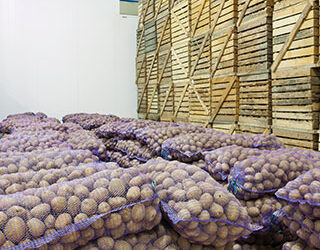Evaporative Air Coolers: A Sustainable Alternative for Attaining Thermal Comfort

Access to cooling for attaining thermal comfort is no longer a luxury but a necessity for improving the overall quality of life and enhanced productivity. Thermal comfort can be defined as a subjective state where an individual is satisfied with their thermal environment, which is determined and affected by various factors. These can be environmental factors like air temperature, relative humidity, airflow, and personal factors like an individual’s clothing & metabolic rate. Achieving and experiencing thermal comfort is essential for an individual’s psychological and physiological well-being and overall productivity.
India’s Access to Cooling
India is one of the largest and fastest-growing economies globally. The cooling demand of a country is a set of multiple variables, of which the country’s per capita GDP and its cooling degree days are the most predominant variables. Despite the growing economy and pressing climatic need for cooling, India is still one of the countries with the lowest access to cooling, with per capita space cooling energy consumption standing as low as 69 kWh as compared to the world average of 272 kWh according to the India Cooling Action Plan (ICAP) 2019.

Though India has around 3000 cooling degree days per year, only a few Indian households have the privilege of owning a room air conditioner (RAC) for attaining thermal comfort. Despite RAC’s low penetration, they still account for a dominant share in building sector space cooling energy consumption. In 2017-18, the building sector space cooling energy consumption from RACs was around ~42% of the overall building energy consumption in India. It is expected to grow to ~52% by 2037-38. Thus, RACs contribute significantly to the peak load and use refrigerants with high global warming potential (GWP), adding to the energy consumption share. India is currently facing the dual challenge of providing affordable access to cooling and extenuating environmental degradation. The evaporative cooling concept that dates back to the medieval era in Indian history, is a panacea for mitigating today’s challenges.
Evaporative Air Coolers as a potential sustainable and affordable solution for increasing access to cooling and thermal comfort

Considering India’s tropical climatic conditions, the impact of RACs on the environment and their low penetration, there is a significant opportunity to promote evaporative air coolers in India. Evaporative air coolers can prove to be an effective alternative technology because it uses sustainable and affordable non-GWP-refrigerant based cooling mechanism. It works reasonably well in Indian climatic conditions to achieve thermal comfort for most of the year until it becomes extremely humid. Evaporative air coolers are also known as desert or swamp coolers and can effectively and efficiently provide thermal comfort for most parts of the India, as shown in Figure 1. These systems are applicable for both commercial and residential settings and can be deployed at a mass scale. This technology uses water, which is a natural refrigerant (R718) and is environment friendly.
 Figure 1: Climate Zones in India where evaporative air coolers work effectively
Figure 1: Climate Zones in India where evaporative air coolers work effectively
Source: Adapted from Bureau of Indian Standards, 2016. National Building Code of India 2016 Volume 2, New Delhi: Bureau of Indian Standards.
In addition to being non-GWP-refrigerant-based technology and adaptable to India’s climatic conditions, evaporative air coolers are an affordable and sustainable space cooling technology. They cost around one-fifth of an air conditioner. According to ICAP, an evaporative air cooler with energy-efficient pumps and fans, has the energy-saving potential of around 20% in the coming decade. This could become a catalyst towards the pressing need to provide sustainable cooling, thermal comfort for all, and reduce the refrigerant demand.
The evaporative air-cooling technology works on the fundamental principle of evaporation of water, leading to an exchange of heat and mass. During this evaporation process, the inlet air’s sensible heat converts into latent heat, which brings down the dry-bulb temperature of the supply air. Specific humidity is added into the cooled supply air during this process. Evaporative air coolers can’t operate effectively in places with higher humidity or with low dry bulb temperatures. In that scenario, air will become highly saturated, the evaporation process will slow down, and evaporative air coolers will become less effective.
 Figure 1: Domestic evaporative air cooler installed in an Indian household
Figure 1: Domestic evaporative air cooler installed in an Indian household
Evaporative air coolers are GWP-refrigerant-free, budget-friendly, easy to maintain, and consume ~80% less electricity than air conditioners. Therefore, an increase in their penetration would act as a significant enabler in reducing energy demand, enhancing thermal comfort and providing wider access to space cooling. If deployed at a large scale, this technology has the potential to be a contributor to India’s Nationally Determined Contributions (NDCs). Moreover, in the coming years, this could also reduce the user’s dependency on RACs which use refrigerants with high GWP. This would ensure India’s compliance with the Montreal Protocol.
Even though evaporative air coolers have been in existence since several decades, their market has been majorly unorganized and lacks performance standards. Focused efforts are required for standardizing the market and leveraging the existing evaporative air cooler technology for wider market adoption by developing its performance standards. This will foster increased access to cooling and thermal comfort for all along with other related co-benefits such as the reduction in refrigerant demand and GHG emissions. Developing performance standards ahead of the demand curve for evaporative air coolers, could also position India as the market leader for export opportunities and domestic trade. This could also contribute towards India’s economic recovery and support the ‘Atmanirbhar Bharat’ initiative of the Government of India. AEEE, being a part of the SHEETAL, has embarked on a mission to create knowledge products enabling the policymakers to take steps toward the development of performance standards for evaporative air coolers.
Stay tuned for more information as AEEE will soon launch the ‘Decoding Evaporative Air Coolers’, a report that lays the foundation stone for the standardisation of the evaporative air coolers market in India. This report will shed light on the technological feasibility, information about standards adopted nationally and internationally, and draws recommendations for India’s evaporative air cooler sector.
Written by Srishti Sharma and Akhil Singhal based on insights and information captured during the development of the Decoding Evaporative Air Coolers Report. Srishti and Akhil work as a Research Associate and a Senior Research Associate, respectively, in the Buildings and Communities vertical at AEEE.
“The Alliance for Sustainable Habitat, Energy Efficiency and Thermal Comfort (SHEETAL) is a consortium of Civil socity organizations led by The Energy and Resource Institute (TERI) with the Alliance for an Energy Efficient Economy (AEEE), and the Council on Energy, Environment and Water (CEEW) as partners. Supported by CIFF, SHEETAL facilitates the roll out of India’s sustainable cooling agenda enshrined in the India Cooling Action Plan. Engaging with national and international stakeholders, the consortium partners discuss, identify and test integrated approaches best suited to improve the development, access and use of energy efficient cooling practices and technologies for R&D, space cooling, cold chain, transport air-conditioning, and the servicing sector. SHEETAL convene different line ministries and international and domestic cooling policy experts to collaborate and synergise actions to accelerate sustainable cooling in India.”




